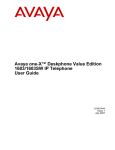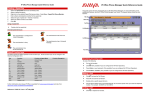Download 1603 User Guide
Transcript
IP Office 4.2 1603 Phone - Issue 01b - (09 September 2008) © 2008 AVAYA All Rights Reserved. Notice While reasonable efforts were made to ensure that the information in this document was complete and accurate at the time of printing, Avaya Inc. can assume no liability for any errors. Changes and corrections to the information in this document may be incorporated in future releases. Documentation Disclaimer Avaya Inc. is not responsible for any modifications, additions, or deletions to the original published version of this documentation unless such modifications, additions, or deletions were performed by Avaya. Link Disclaimer Avaya Inc. is not responsible for the contents or reliability of any linked Web sites referenced elsewhere within this Documentation, and Avaya does not necessarily endorse the products, services, or information described or offered within them. We cannot guarantee that these links will work all of the time and we have no control over the availability of the linked pages. License USE OR INSTALLATION OF THE PRODUCT INDICATES THE END USER’S ACCEPTANCE OF THE TERMS SET FORTH HEREIN AND THE GENERAL LICENSE TERMS AVAILABLE ON THE AVAYA WEBSITE AT http://support.avaya.com/LicenseInfo/ (“GENERAL LICENSE TERMS”). IF YOU DO NOT WISH TO BE BOUND BY THESE TERMS, YOU MUST RETURN THE PRODUCT(S) TO THE POINT OF PURCHASE WITHIN TEN (10) DAYS OF DELIVERY FOR A REFUND OR CREDIT. Avaya grants End User a license within the scope of the license types described below. The applicable number of licenses and units of capacity for which the license is granted will be one (1), unless a different number of licenses or units of capacity is specified in the Documentation or other materials available to End User. “Designated Processor” means a single stand-alone computing device. “Server” means a Designated Processor that hosts a software application to be accessed by multiple users. “Software” means the computer programs in object code, originally licensed by Avaya and ultimately utilized by End User, whether as stand-alone Products or pre-installed on Hardware. “Hardware” means the standard hardware Products, originally sold by Avaya and ultimately utilized by End User. License Type(s): Designated System(s) License (DS). End User may install and use each copy of the Software on only one Designated Processor, unless a different number of Designated Processors is indicated in the Documentation or other materials available to End User. Avaya may require the Designated Processor(s) to be identified by type, serial number, feature key, location or other specific designation, or to be provided by End User to Avaya through electronic means established by Avaya specifically for this purpose. Copyright Except where expressly stated otherwise, the Product is protected by copyright and other laws respecting proprietary rights. Unauthorized reproduction, transfer, and or use can be a criminal, as well as a civil, offense under the applicable law. Third-Party Components Certain software programs or portions thereof included in the Product may contain software distributed under third party agreements (“Third Party Components”), which may contain terms that expand or limit rights to use certain portions of the Product (“Third Party Terms”). Information identifying Third Party Components and the Third Party Terms that apply to them is available on Avaya’s web site at: http://support.avaya.com/ThirdPartyLicense/ Avaya Fraud Intervention If you suspect that you are being victimized by toll fraud and you need technical assistance or support, call Technical Service Center Toll Fraud Intervention Hotline at +1-800-643-2353 for the United States and Canada. Suspected security vulnerabilities with Avaya Products should be reported to Avaya by sending mail to: [email protected]. For additional support telephone numbers, see the Avaya Support web site (http://www.avaya.com/support). Trademarks Avaya and the Avaya logo are registered trademarks of Avaya Inc. in the United States of America and other jurisdictions. Unless otherwise provided in this document, marks identified by “®,” “™” and “SM” are registered marks, trademarks and service marks, respectively, of Avaya Inc. All other trademarks are the property of their respective owners. Documentation information For the most current versions of documentation, go to the Avaya Support web site (http://www.avaya.com/support) or the IP Office Knowledge Base (http://marketingtools.avaya.com/knowledgebase/). Avaya Support Avaya provides a telephone number for you to use to report problems or to ask questions about your contact center. The support telephone number is 1 800 628 2888 in the United States. For additional support telephone numbers, see the Avaya Web site: http://www.avaya.com/support. 1603 Phone IP Office 4.2 Page 2 - Issue 01b (09 September 2008) Contents Contents 1. 1603 1.1 About LEDs..................................................................... 9 1.2 About Icons ..................................................................... 10 1.3 About Paper ..................................................................... Labels 10 2. Basic Telephone Operation 2.1 Making a Call ..................................................................... 12 2.2 Redialling a..................................................................... Number 12 2.3 Answering ..................................................................... a Call 12 2.4 Muting a Call ..................................................................... 13 2.5 Putting a Call ..................................................................... on Hold 13 2.6 Transferring ..................................................................... a Call 13 2.7 Conference..................................................................... Calls 14 2.8 Getting Your ..................................................................... Messages 15 2.9 Logging in ..................................................................... to your Telephone 15 2.10 The Avaya ..................................................................... Menu 16 Index ...............................................................................0 1603 Phone IP Office 4.2 Page 3 - Issue 01b (09 September 2008) Chapter 1. 1603 1603 Phone IP Office 4.2 Page 5 - Issue 01b (09 September 2008) 1603: 1. 1603 The 1603 IP telephone is a multi line IP telephone for use with Avaya IP Office. The 1603 IP telephone puts convenient features and capabilities at your fingertips, including a Conference, Transfer, Hold, and Redial button and a menu of options and settings to customize your phone. Not all features described in this user guide may be available on your telephone. If you find that a feature is not available, contact your system administrator. 1603 Phone IP Office 4.2 Page 7 - Issue 01b (09 September 2008) Name Description Message Waiting Indicator An illuminated red light in the upper-right corner of your phone indicates you have voicemail messages waiting. If Visual Alerting is enabled, this light flashes when you receive an incoming call. Avaya Menu Press the A button to access the Avaya menu. Press the A button twice to exit the Avaya menu. The Avaya menu provides options that allow you to customize phone settings, select the display language, view network information, and log out. Redial Press Redial to dial the last number you dialed. Hold Press Hold to put the active call on hold. Conference Press Conference to add another party to an existing call. Transfer Press Transfer to transfer a call to another number. Drop Press Drop to drop the active call. While on a conference call, press Drop to drop the last person added to the conference call. Volume Press + or - on the volume button while active on the handset or speaker to adjust the volume. To adjust the volume of the ringer, press + or - on the volume button while the handset and speaker are inactive. Mute Press Mute to mute a call in progress. To take a call off mute, press Mute again. Speaker Press Speaker to use the speakerphone. To take a call off speakerphone, lift the handset. Feature Buttons and Call/Line Appearance Buttons There are 3 buttons that can be programmed by the system administrator as either call/line appearance buttons or feature buttons. Press a call/line appearance button to make or answer a call or resume a call on hold. Press a labeled feature button to enable or disable that feature. Typically, two buttons are administered as call/ line appearance buttons and one button is administered as a feature button. The feature button provides access to an Avaya call management system feature that has been administered for your extension. The green LED next to the feature button indicates if the feature is currently on or off. If the light is on, the feature is on. 1603 Phone IP Office 4.2 Page 8 - Issue 01b (09 September 2008) 1603: 1.1 About LEDs Each call/line appearance button and feature button has two LEDs, one green and one red, to indicate the status of the call/line appearance or feature. The status is identified by whether the LED is turned on, off, or blinking as described in the following tables. Table 1. Call/Line Appearance Button LEDs LED Description Steady green Call/line appearance is active. Slow blinking green Call/line appearance is ringing. Fast blinking green Call/line appearance is on hold. Very fast blinking green Conference or Transfer is pending. Steady red Call/line appearance is selected and will be used when you go off-hook. It remains steady red while you use the call/line appearance. Off Call/line appearance is available. Table 2. Feature Button LEDs LED Description Steady green Feature is active. Blinking green Feature is pending (request is being processed and not immediately available). Off Feature is not active. 1603 Phone IP Office 4.2 Page 9 - Issue 01b (09 September 2008) 1.2 About Icons Icons are provided in the phone display to indicate the state of a call and navigation choices. The icons that appear in the phone display are described in the following table. Table 3. Icons in the Telephone Display Icon Description Call forward or Send All Calls is active. (These features are available if they have been administered for your telephone.) Incoming call is ringing. Call is active. Call is on hold. Call is on soft hold (when using Conference or Transfer feature). Conference is active. Conference is on hold. Scroll up or down for other options. 1.3 About Paper Labels Next to each call/line appearance button and feature button is a paper label. The label identifies the call/line appearance number or the feature that has been programmed on the button by your system administrator. You can remove the labels if you want to change a label or write on a blank one. Printed labels are also available for your telephone. See your system administrator for more information. 1603 Phone IP Office 4.2 Page 10 - Issue 01b (09 September 2008) Chapter 2. Basic Telephone Operation 1603 Phone IP Office 4.2 Page 11 - Issue 01b (09 September 2008) 2. Basic Telephone Operation 2.1 Making a Call If you are not on a call, simply dial the number you want to call. 1. Lift the handset, press Speaker or press an available line button. 2. Dial the number you want to call. 2.2 Redialling a Number Press Redial to call the last number dialed. 2.3 Answering a Call When you receive an incoming call, the incoming call is usually selected automatically. However, if you are already on a call or if you receive more than one incoming call at a time, you may need to select the call you want to answer manually. Answer an incoming call in the following ways: · If you are not on another call, lift the handset, or press the call/line appearance button whose green LED flashes for the incoming call, or press Speaker to answer using the speakerphone. · If you are on another call, press the call/line appearance button whose green LED flashes for the incoming call. · 1603 Phone IP Office 4.2 If the Auto Hold feature is enabled by your system administrator, you can answer another call without first putting an active call on hold. If Auto Hold is not enabled, you must put your active call on hold before answering the incoming call; otherwise, you will drop the active call when you answer the other one. Page 12 - Issue 01b (09 September 2008) Basic Telephone Operation: Answering a Call 2.4 Muting a Call If a call is on mute and you switch between the handset, headset, or speakerphone, the mute will be turned off. When the Mute button light is on, the call is muted. 1. Press the Mute button during a call so that the other person cannot hear you. 2. Press the Mute button again to unmute the call. 2.5 Putting a Call on Hold 1. Press Hold to put your active call on hold. The fast blinking green LED next to the call/line appearance button indicates the call is on hold. 2. To resume the call, press the call/line appearance button to resume the call. 2.6 Transferring a Call 1. If the call you want to transfer is not your active call, press the call/line appearance button for the call you want to transfer. 2. Press Transfer. · 3. Dial the telephone number. · 4. The very fast blinking green LED next to the call/line appearance button indicates the call is being transferred. To transfer the call to a call that is on hold, press the call/line appearance button for the call that is on hold. Press Transfer again or hang up to complete the transfer. 1603 Phone IP Office 4.2 Page 13 - Issue 01b (09 September 2008) 2.7 Conference Calls You can use conference calls to speak with up to three people in different locations on the same call. Additional conferencing options may be available through Expanded Meet-Me Conferencing. Contact your system administrator for more information about this feature. Making a conference call 1. While active on a call, press Conference. · Note: The very fast blinking green LED next to the call/line appearance button indicates the call is being conferenced. 2. Dial the telephone number. 3. Press Conference to add the person to the existing call. Putting a conference call on hold When you put a conference call on hold, the other parties can still talk to each other. 1. Press Hold during a conference call. The blinking green LED next to the call/line appearance button indicates the conference is on hold. 2. To resume the call, press the call/line appearance button to resume the call. Dropping a person from a conference call 1. While active on a conference call, press Drop. 2. Press # to drop the person shown, press * to view the next person. 1603 Phone IP Office 4.2 Page 14 - Issue 01b (09 September 2008) Basic Telephone Operation: Conference Calls 2.8 Getting Your Messages A red light on the upper right-hand corner of your telephone indicates when you have messages waiting. Your messages are an administered function. Contact your system administrator with any questions. Logging into your voice mail 1. To log in to your voice mail, follow the instructions provided by your system administrator. 2. Once you are logged in, follow the voice prompts from your voice mail system. 2.9 Logging in to your Telephone Logging in and out maintains your personal options if you share a telephone with other users or if you want to use the same extension from another phone. Logging out also prevents unauthorized use of your telephone during an absence. Logging in to your telephone Log in from the initial screen that prompts you for your extension. 1. Enter your extension. 2. Press # to select OK. 3. Enter your password. 4. Press # to select OK. Logging out of your telephone 1. Press the A button. 2. Press # to scroll to Log Out. Note:Log Out is not available if you are on a call. 3. Press * to select Log Out. 4. Press * again to confirm. 1603 Phone IP Office 4.2 Page 15 - Issue 01b (09 September 2008) 2.10 The Avaya Menu You can use the Avaya Menu to adjust and customize phone settings, select the display language, view network settings, and log out. To access the Avaya Menu, press the A button. To exit the Avaya Menu, press the A button twice. The Avaya Menu has five sub-menus: · Screen Lets you adjust the display brightness and contrast and turn visual alerting on and off. · Sounds Lets you select your ringing pattern, turn button click sounds on and off, and turn error tones on and off. · Advanced Lets you select the display language, set automatic gain control on the handset and speaker, or initiate a manual backup/restore if you have a backup/ restore file server. See your system administrator for more information. · Network Information Shows a summary of network-related parameters for your phone, such as IP parameters and Quality of Service. · Log Out Lets you log out of your telephone to prevent unauthorized use during your absence. Note: · The sub-menus that appear depend on how your extension was administered. Some sub-menus may not be available. Adjusting the brightness or contrast of the display 1. Press the A button. 2. Press # to continue. 3. Press * to select Screen. 4. Press # to scroll to Bright or Contrast. 5. Press - or + on the volume button to adjust the brightness or contrast. Changing the ring pattern 1. Press the A button. 2. Press # to scroll to Sounds. 3. Press * to select Sounds. 4. Press - or + on the volume button to select a ring type. You hear each ring type when you select them. 1603 Phone IP Office 4.2 Page 16 - Issue 01b (09 September 2008) Basic Telephone Operation: The Avaya Menu Turning button click sounds on and off 1. Press the A button. 2. Press # to scroll to Sounds. 3. Press * to select Sounds. 4. Press # to select Next. 5. Press - or + on the volume button to turn button click sounds on and off. Turning error tones on or off 1. Press the A button. 2. Press # to scroll to Sounds. 3. Press * to select Sounds. 4. Press # to scroll to Error Tones. 5. Press - or + on the volume button to turn error tones on or off. Turning visual alerting on or off When the Visual Alerting option is turned on, incoming calls cause the LED in the top right corner of the phone to flash. You can turn Visual Alerting on or off. 1. Press the A button. 2. Press # to continue. 3. Press * to select Screen. 4. Press # to scroll to Visual Alert. 5. Press - or + on the volume button to turn visual alerting on or off. Setting Automatic Gain Control Automatic Gain Control helps to maintain a constant audio level by automatically increasing or decreasing the gain depending upon the signal level. For high level signals, the gain is reduced and for low level signals, the gain is increased. 1. Press the A button. 2. Press # to scroll to Advanced. 3. Press * to select Advanced. 4. Press # to select AGCHandset or AGCSpeaker. 5. Press - or + on the volume button to turn automatic gain control on or off. 1603 Phone IP Office 4.2 Page 17 - Issue 01b (09 September 2008) Changing the language 1. Press the A button. 2. Press # to scroll to Advanced. 3. Press * to select Advanced. 4. Press # to scroll to Language. 5. Press * to select Language. 6. Press # to scroll to the desired language. Other languages may be available. Contact your system administrator. 7. Press * to save your selection. 8. Press 4 to confirm or 6 to cancel. Viewing Network Information 1. Press the A button. 2. Press # to scroll to Network Info. 3. Press * to select Network Info. 4. Press # to scroll to Audio Info, IP Info, QoS, Interfaces, or Miscellaneous. 5. Press * to view information for the item you selected. 1603 Phone IP Office 4.2 Page 18 - Issue 01b (09 September 2008) 1603 Phone IP Office 4.2 Page 19 - Issue 01b (09 September 2008) Performance figures and data quoted in this document are typical, and must be specifically confirmed in writing by Avaya before they become applicable to any particular order or contract. The company reserves the right to make alterations or amendments to the detailed specifications at its discretion. The publication of information in this document does not imply freedom from patent or other protective rights of Avaya or others. Intellectual property related to this product (including trademarks) and registered to Lucent Technologies have been transferred or licensed to Avaya. All trademarks identified by the ® or ™ are registered trademarks or trademarks, respectively, of Avaya Inc. All other trademarks are the property of their respective owners. This document contains proprietary information of Avaya and is not to be disclosed or used except in accordance with applicable agreements. Any comments or suggestions regarding this document should be sent to "[email protected]". © 2008 Avaya Inc. All rights reserved. Avaya Unit 1, Sterling Court 15 - 21 Mundells Welwyn Garden City Hertfordshire AL7 1LZ England. Tel: +44 (0) 1707 392200 Fax: +44 (0) 1707 376933 Web: http://www.avaya.com/ipoffice/knowledgebase 1603 Phone IP Office 4.2 Page 20 - Issue 01b (09 September 2008)









































